Zygnematales
| Zygnematales | |
|---|---|
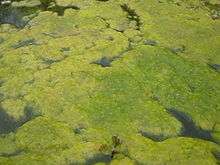 | |
| Spirogyra green algae | |
| Scientific classification | |
| Kingdom: | Plantae |
| Division: | Charophyta |
| Class: | Zygnematophyceae |
| Order: | Zygnematales C.E.Bessey, 1907 |
| Families | |
| Synonyms | |
|
Zygnematales Borge and Pascher, 1913 | |
The Zygnematales (Greek: ζυγός (zygos) + νήμα (nēma) (nom.), νήματος (nēmatos) (gen.)), also called the Conjugatales, are an order of green algae,[1] comprising several thousand different species in two families. The larger family Zygnemataceae, with well-known genera such as Zygnema and Spirogyra, includes members that grow as unbranched filaments, which grow longer through normal cell division. The smaller family Mesotaeniaceae includes the saccoderm "desmids", a group of unicellular species that were formerly classified with the "true" desmids. Most members of both families live in freshwater, and form an important component of the algal scum that grows on or near plants, rocks, and various debris.
Systematically they fall within the division Charophyta, which includes the groups of algae that are most closely related to the higher plants. Charophyta are included with land plants (Embryophyta) in the clade Streptophyta.[2]
Sexual reproduction in Zygnematales takes place through a process called conjugation.[3] Here filaments of opposite gender line up, and tubes form between corresponding cells. The male cells then become amoeboid and crawl across, or sometimes both cells crawl into the tube. The cells then meet and fuse to form a zygote, which later undergoes meiosis to produce new filaments. As in plants, only the female passes chloroplasts on to the offspring.
The only other group of conjugating algae are the desmids, which live as individual cells often with a striking symmetrical appearance. The desmids are sometimes placed in a separate order Desmidiales, which is closely related to Zygnematales, and the two are placed together in the class Zygnematophyceae.
Gallery
 Netrium oblongum. A saccoderm "desmid"
Netrium oblongum. A saccoderm "desmid"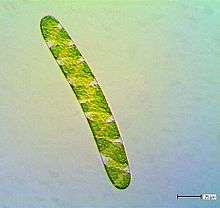 Spirotaenia condensata. A saccoderm "desmid"
Spirotaenia condensata. A saccoderm "desmid"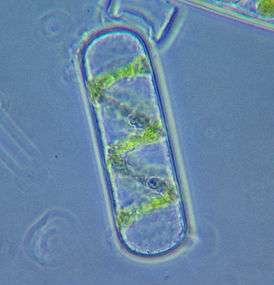 Single Spirogyra cell
Single Spirogyra cell Spirogyra. Each numbered tick = 122 µM
Spirogyra. Each numbered tick = 122 µM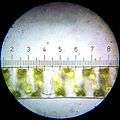 Spirogyra. Each numbered tick = 20 µM
Spirogyra. Each numbered tick = 20 µM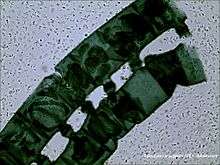 Microscopic view of Spirogyra conjugation
Microscopic view of Spirogyra conjugation Zygnema. Each numbered tick = 122 µM
Zygnema. Each numbered tick = 122 µM Zygnema. Each numbered tick = 20 µM
Zygnema. Each numbered tick = 20 µM
References
- ↑ Turmel M, Otis C, Lemieux C (2005). "The complete chloroplast DNA sequences of the charophycean green algae Staurastrum and Zygnema reveal that the chloroplast genome underwent extensive changes during the evolution of the Zygnematales". BMC Biol. 3: 22. doi:10.1186/1741-7007-3-22. PMC 1277820
 . PMID 16236178.
. PMID 16236178. - ↑ http://esciencenews.com/articles/2011/04/17/ancestors.land.plants.revealed
- ↑ Kapraun DF (April 2007). "Nuclear DNA Content Estimates in Green Algal Lineages: Chlorophyta and Streptophyta". Ann. Bot. 99 (4): 677–701. doi:10.1093/aob/mcl294. PMC 2802934
 . PMID 17272304.
. PMID 17272304.